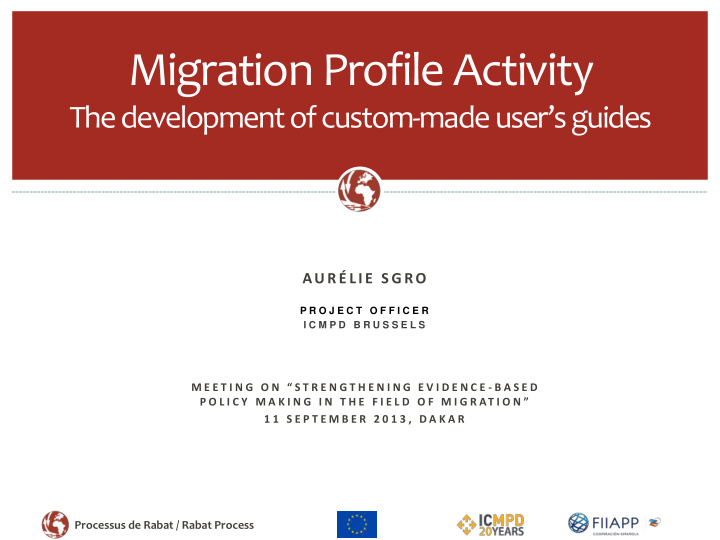



Migration Profile Activity The development of custom- made user’s guides AU R É L I E S G RO P R O J E C T O F F I C E R I C M P D B R U S S E L S M E E T I N G O N “ S T R E N G T H E N I N G E V I D E N C E - B A S E D P O L I C Y M A K I N G I N T H E F I E L D O F M I G R AT I O N ” 1 1 S E P T E M B E R 2 0 1 3 , D A K A R Processus de Rabat / Rabat Process
Contents State of play on migration profiles 1. Logic of the activity – identified problems 2. Objectives of the activity 3. Suggested endpoint: a user’s guide 4. Suggestion on how to structure the guide 5. Working methods 6. Timetable for implementation 7. Processus de Rabat / Rabat Process
1. State of play on migration profiles OBJECTIVES To improve migration governance To encourage evidence-based decision making in this field FORMAT From a short statistical report to extended versions Dialogue tool Information package FUNCTIONS Policy/programme development and Capacity building tool evaluation tool Processus de Rabat / Rabat Process
2. Logic of the activity – identified problems Framework of the general objective of favouring knowledge building and development to: support policy making better understand the migration situation of partner countries and coordinate efforts Main challenges in the use of migration data and profiles Limited use Difficult to Poor Insufficient Poor update of migration understand dissemination ownership capability data Processus de Rabat / Rabat Process
3. Objectives of the activity To identify migration information sources and users To have a common understanding of the use of migration information To present and transfer best practices in the use of migration profiles To contribute to the coordination of national migration policies Processus de Rabat / Rabat Process
4. Suggested endpoint: a user’s guide Concise guides customised to each participating country Results also available on the i-Map Special focus put on border management and migration in crisis situations A tool to complete migration profiles Processus de Rabat / Rabat Process
5. Suggestion on how to structure the guide Overview of data and information sources in the field I. of migration The migration policy cycle and its actors II. III. The migration profile process: Contents Members of the workgroup Best practices / use examples Problem/solution matrix IV. Recommendations Processus de Rabat / Rabat Process
5. Suggestion on how to structure the guide Overview of data and information sources in the field I. of migration INFORMATION SOURCE MAPPING (existing and potential sources) GOVERNMENTAL ENTITIES Areas Data collection entities (and contacts) (by way of example – without limitation) Trends Border management Migration in crisis situations Migration and development OTHERS (including international, academic and other types of organisations) Areas Data collection entities (and contacts) (by way of example – without limitation) Trends Border management Migration in crisis situations Processus de Rabat / Rabat Process
5. Suggestion on how to structure the guide The migration policy cycle and its actors II. Identification of needs Reformulation Processing Follow-up Decision Implementation Processus de Rabat / Rabat Process
5. Suggestion on how to structure the guide III. The migration profile process MEMBERS OF THE WORKGROUP / COORDINATION PLATFORM COORDINATOR: BEST PRACTICES / MIGRATION PROFILE USE EXAMPLES PROBLEM / SOLUTION MATRIX 1 st challenge in the use of a • Corrective actions / past successful strategies migration profile • Corrective actions / past successful strategies 2 nd challenge in the use of a migration profile Processus de Rabat / Rabat Process
5. Structure suggestion for the final product IV. Recommendations RECOMMENDATIONS (examples, without limitation) On cooperation On training and human resources On improving information acquisition On information in the field of border management On information in the field of migration in crisis situations Processus de Rabat / Rabat Process
6. Working methods Guide customised to each participating country Components ensuring ownership : Close involvement of all national authorities in charge of migration issues and set-up of a workgroup A capacity-building component : organisation of national discussion and training workshops to identify needs, challenges and recommendations through the assistance of international and local experts Final endorsement of the guide by the national coordinating authority prior to its publishing Processus de Rabat / Rabat Process
7. Timetable for implementation Sep - Nov 2013 Acquisition of expressions of interest from States willing to participate in the initiative and identification of stakeholders Compilation and analysis of questionnaires with national Nov - Jan 2014 authorities in charge of migration issues and departmental surveys Organisation of national discussion and training Feb - Jun 2014 workshops in participating countries After each workshop: Analysis of results and compilation of the guide by the consortium and experts Endorsement of the guide by the national coordinating authority and publication Mid-2014 Presentation of preliminary results to the SOM (Senior Officials Meeting) Until May 2015 Activity follow-up Processus de Rabat / Rabat Process
Any questions? Thank you for your attention Contact info@processusderabat.net Processus de Rabat / Rabat Process
Recommend
More recommend